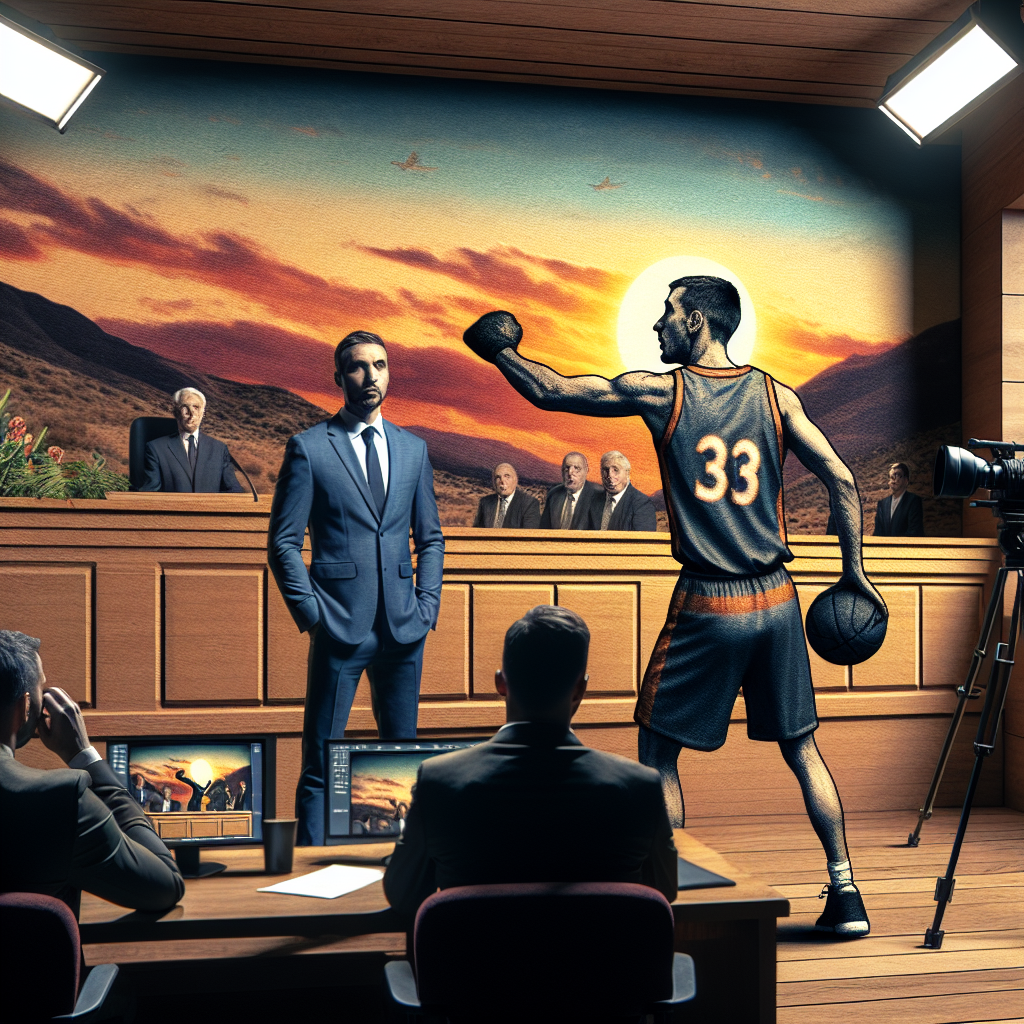Ja Morant says in court he punched the teen in self-defense

Legal Implications Of Ja Morant’s Self-Defense Claim
Ja Morant, the Memphis Grizzlies’ star point guard, recently found himself embroiled in a legal controversy that has captured widespread attention. The incident in question involves an altercation with a teenage boy, during which Morant claims he acted in self-defense. This assertion, while potentially exculpatory, carries significant legal implications that merit careful examination.
In court, Morant testified that he punched the teenager in self-defense, a claim that hinges on the legal principle of justifiable use of force. Self-defense is a well-established doctrine in criminal law, allowing individuals to use reasonable force to protect themselves from imminent harm. However, the application of this principle is not always straightforward and often depends on the specific circumstances surrounding the incident.
To substantiate a self-defense claim, the defendant must demonstrate that they had a reasonable belief that they were in imminent danger of bodily harm. This belief must be both subjectively genuine and objectively reasonable. In Morant’s case, his legal team will need to provide evidence that supports his perception of an immediate threat posed by the teenager. This could include witness testimonies, video footage, or any other relevant documentation that corroborates his account of the events.
Moreover, the proportionality of the response is a critical factor in self-defense cases. The force used in self-defense must be commensurate with the threat faced. If Morant’s actions are deemed excessive relative to the perceived danger, his self-defense claim could be undermined. The court will scrutinize whether the punch was a necessary and appropriate response to the situation, considering the size, strength, and behavior of both parties involved.
Another layer of complexity arises from the fact that the altercation involved a minor. The legal system often affords additional protections to juveniles, and any use of force against a minor is subject to heightened scrutiny. Morant’s defense will need to navigate these sensitivities carefully, ensuring that their arguments do not appear to trivialize the seriousness of the incident or the vulnerability of the teenager.
Furthermore, the public and media attention surrounding the case adds another dimension to the legal proceedings. High-profile cases often come with increased pressure on all parties involved, including the judiciary. The court must remain impartial and base its decisions solely on the evidence presented, despite the external noise. However, the influence of public opinion cannot be entirely discounted, as it can shape the broader narrative and potentially impact the reputations of those involved.
In addition to the immediate legal ramifications, the outcome of this case could have long-term consequences for Morant’s career. Professional athletes are often held to higher standards of conduct, both on and off the field. Any legal entanglements can affect their public image, endorsement deals, and even their standing within their respective sports organizations. As such, Morant’s legal team will be acutely aware of the broader implications of this case and will likely strive to resolve it in a manner that minimizes damage to his professional and personal reputation.
In conclusion, Ja Morant’s self-defense claim in the altercation with a teenager presents a multifaceted legal challenge. The court will need to carefully evaluate the reasonableness of Morant’s belief in imminent danger, the proportionality of his response, and the additional considerations related to the involvement of a minor. The outcome of this case will not only determine Morant’s legal standing but could also have significant repercussions for his career and public image. As the proceedings unfold, the legal community and the public alike will be watching closely, underscoring the high stakes involved in this contentious matter.
Public Reaction To Ja Morant’s Court Testimony

Ja Morant, the Memphis Grizzlies’ star point guard, recently found himself at the center of a legal controversy that has captured public attention. During a court testimony, Morant stated that he punched a teenage boy in self-defense, a claim that has sparked a wide range of reactions from fans, analysts, and the general public. As the details of the incident and the subsequent legal proceedings continue to unfold, the public’s response has been both varied and intense.
In his testimony, Morant recounted the events leading up to the altercation, emphasizing that he felt threatened by the teenager’s actions. According to Morant, the situation escalated quickly, leaving him with no choice but to defend himself. This assertion has been met with a mixture of skepticism and support, reflecting the complex nature of public opinion in high-profile cases involving celebrities.
On one hand, a segment of the public has expressed unwavering support for Morant, citing his right to self-defense. These supporters argue that, regardless of his status as a professional athlete, Morant is entitled to protect himself when he perceives a threat. They point to his consistent on-court demeanor and philanthropic efforts off the court as evidence of his character, suggesting that the incident was an unfortunate but isolated event.
Conversely, there are those who question the validity of Morant’s self-defense claim. Critics argue that, given his physical prowess and training as an elite athlete, Morant’s response may have been disproportionate to the threat posed by a teenager. This perspective is fueled by concerns over the potential misuse of self-defense claims by individuals in positions of power or influence. Additionally, some detractors highlight the broader issue of violence in sports, suggesting that incidents like this one contribute to a culture that normalizes aggressive behavior.
The media’s role in shaping public perception cannot be overlooked. Coverage of Morant’s testimony has varied widely, with some outlets focusing on his account of self-defense and others scrutinizing the details of the altercation. This disparity in reporting has further polarized public opinion, as individuals often rely on media narratives to form their views on such matters. Social media platforms have also played a significant role, with hashtags and trending topics amplifying both support and criticism of Morant.
Legal experts have weighed in on the case, offering insights into the complexities of self-defense claims. They note that the burden of proof lies with Morant to demonstrate that his actions were justified under the circumstances. This involves not only establishing the presence of a credible threat but also showing that his response was reasonable and proportionate. As the legal process continues, these nuances will be critical in determining the outcome of the case.
In the court of public opinion, however, the lines are often less clear-cut. Fans and observers bring their own biases and experiences to their interpretations of the incident, leading to a diverse array of reactions. Some view Morant as a victim of circumstance, while others see him as an aggressor who overstepped the bounds of acceptable behavior.
Ultimately, the public reaction to Ja Morant’s court testimony underscores the complexities inherent in high-profile legal cases. As the legal proceedings move forward, the court’s findings will undoubtedly influence public sentiment. However, the broader conversation about self-defense, celebrity, and accountability will likely continue, reflecting the ongoing tension between individual actions and societal expectations.
Impact On Ja Morant’s Career Following Self-Defense Admission
Ja Morant, the Memphis Grizzlies’ star point guard, recently found himself at the center of a legal controversy that has significant implications for his career. In a court appearance, Morant admitted to punching a teenager but claimed it was an act of self-defense. This admission has sparked widespread discussion about the potential impact on his professional trajectory, both on and off the court.
The incident in question reportedly took place during a pickup basketball game at Morant’s residence. According to court documents, the altercation began when the teenager allegedly threw a basketball at Morant’s face, prompting the NBA player to respond physically. Morant’s legal team has argued that his actions were a necessary response to an immediate threat, framing the punch as a defensive maneuver rather than an unprovoked attack. This narrative aims to mitigate the negative fallout from the incident, but the ramifications for Morant’s career are multifaceted and complex.
Firstly, the legal proceedings themselves could have a direct impact on Morant’s availability for games and team activities. If the court finds him guilty of any wrongdoing, he could face suspensions or fines from the NBA, which has a strict code of conduct for its players. Even if he is exonerated, the time and energy spent dealing with legal matters could detract from his focus on basketball, potentially affecting his performance on the court.
Moreover, the public perception of Morant is likely to be influenced by this incident. Athletes are often held to high standards of behavior, both as representatives of their teams and as role models for young fans. An admission of physical violence, even in self-defense, can tarnish an athlete’s image and lead to a loss of endorsement deals. Companies that have partnered with Morant may reconsider their associations, fearing that the negative publicity could harm their brands. This could result in a significant financial setback for the young star, who has already secured lucrative sponsorships early in his career.
Additionally, the incident could affect team dynamics within the Memphis Grizzlies organization. Teammates and coaching staff may have varying reactions to Morant’s actions and the subsequent media coverage. While some may support him, understanding the pressures and challenges of being a high-profile athlete, others might view the situation as a distraction that could hinder the team’s cohesion and performance. The Grizzlies’ management will also have to navigate the public relations aspect carefully, balancing their support for Morant with the need to uphold the team’s reputation.
Furthermore, this situation serves as a cautionary tale for other athletes about the importance of conflict resolution and personal conduct. The pressures of fame and the competitive nature of sports can sometimes lead to heated moments, but the consequences of such actions can be far-reaching. Morant’s case underscores the need for professional athletes to be mindful of their behavior, both in public and private settings.
In conclusion, Ja Morant’s admission of punching a teenager in self-defense has far-reaching implications for his career. The legal outcomes, public perception, financial repercussions, and internal team dynamics all stand to be affected by this incident. As the situation unfolds, it will be crucial for Morant to navigate these challenges carefully to mitigate the impact on his promising career.

